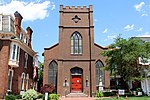Episcopal Diocese of Central Pennsylvania
Dioceses of the Episcopal Church (United States)Episcopal Church in PennsylvaniaEpiscopal Diocese of Central PennsylvaniaEpiscopal bishops of Central PennsylvaniaProvince 3 of the Episcopal Church (United States)

The Episcopal Diocese of Central Pennsylvania is one of the dioceses of the Episcopal Church in the United States of America. It was founded in 1905 as the Diocese of Harrisburg, separating from the original Diocese of Central Pennsylvania now known as the Episcopal Diocese of Bethlehem.The seat of the bishop and home of the diocesan offices is St. Stephen's Episcopal Cathedral at 221 North Front Street in Downtown Harrisburg, Pennsylvania.
Excerpt from the Wikipedia article Episcopal Diocese of Central Pennsylvania (License: CC BY-SA 3.0, Authors, Images).Episcopal Diocese of Central Pennsylvania
Pine Street, Harrisburg
Geographical coordinates (GPS) Address Nearby Places Show on map
Geographical coordinates (GPS)
| Latitude | Longitude |
|---|---|
| N 40.26104 ° | E -76.88605 ° |
Address
Episcopal Diocese of Central Pennsylvania
Pine Street
17101 Harrisburg
Pennsylvania, United States
Open on Google Maps









